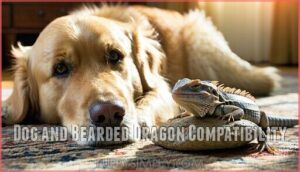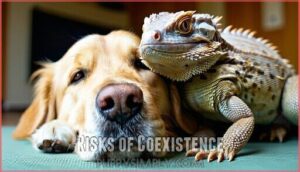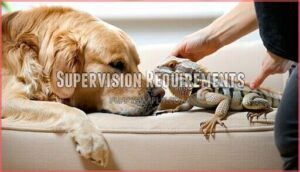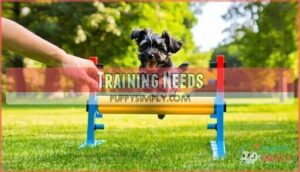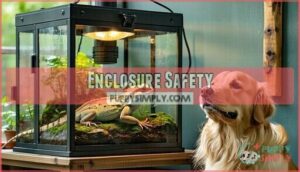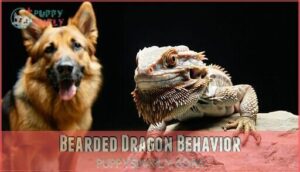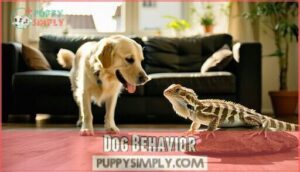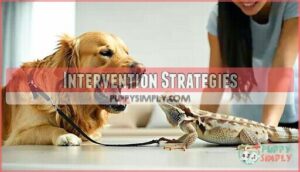This site is supported by our readers. We may earn a commission, at no cost to you, if you purchase through links.
 Bearded dragons and dogs can get along, but it’s not automatic.
Bearded dragons and dogs can get along, but it’s not automatic.
Your dog’s temperament matters most – calm, gentle breeds typically do better than high-energy or prey-driven ones.
You’ll need constant supervision during interactions since dogs might see your bearded dragon as a toy or snack.
Start with slow introductions through glass barriers.
Never leave them alone together.
Your bearded dragon needs secure spaces to retreat when stressed.
Some dogs learn to respect their scaly housemate, while others never quite grasp the "don’t chase" concept.
Success depends on proper training, careful management, and reading both pets’ body language signals.
Table Of Contents
- Key Takeaways
- Bearded Dragons and Dogs
- Do Bearded Dragons Get Along
- Dog and Bearded Dragon Compatibility
- Risks of Coexistence
- Safe Interaction Guidelines
- Signs of Stress and Aggression
- Coexistence Alternatives
- Frequently Asked Questions (FAQs)
- How do bearded dragons react to dogs?
- Can you have a bearded dragon with a dog?
- How to introduce a bearded dragon to a dog?
- What animals can live with a bearded dragon?
- What type of Bearded Dragon is best for living with a dog?
- How do I know if my Bearded Dragon is comfortable with my dog?
- Are there any special considerations for introducing a puppy to a Bearded Dragon?
- Are there any enrichment activities that I can do with my Bearded Dragon and dog?
- How often should I supervise interactions between my Bearded Dragon and my dog?
- Can bearded dragons recognize their dog companions?
- Conclusion
Key Takeaways
- Your dog’s temperament matters more than breed – Calm, gentle dogs adapt better to bearded dragons than high-energy or prey-driven ones, but you’ll still need constant supervision during any interaction.
- Never leave them alone together – Even well-trained dogs can accidentally harm your bearded dragon, and reptiles naturally see dogs as predators, creating stress that can lead to serious health issues.
- Start with secure, gradual introductions – Keep your bearded dragon safely in its terrarium while your dog observes from across the room, then slowly decrease the distance over several days while watching both pets’ body language.
- Success isn’t guaranteed and alternatives exist – Most bearded dragons prefer living alone, so if coexistence creates ongoing stress, separate housing or rehoming one pet might be the kindest choice for both animals’ wellbeing.
Bearded Dragons and Dogs
You’re probably wondering if your bearded dragon and dog can share the same space safely.
The answer isn’t straightforward since these two pets have very different needs and natural instincts that can create challenges.
Initial Interactions
Your first terrarium introduction sets the tone for everything that follows.
Your introduction moment determines whether your pets will peacefully coexist or constantly stress each other out.
Start with your bearded dragon safely inside their enclosure while your dog observes from across the room.
Create a calm environment free from distractions or loud noises.
Watch both pets’ body language carefully during this supervised introduction.
Gradual methods work best—rushing this process in neutral territory rarely ends well, as it is crucial to prioritize a peaceful and supervised introduction.
Safety Precautions
When introducing your bearded dragon and dog, constant supervision isn’t optional—it’s essential for safe pet combinations.
Never leave them alone together, even briefly. Secure your dragon’s enclosure with locks to prevent curious paws from opening it.
Consider investing in a dog proof enclosure for added safety.
Practice proper hygiene after handling either pet to prevent disease transmission. Remember, bite risks exist from both animals when stressed, so always maintain control during introductions.
Environmental Considerations
Beyond safety measures, your home setup determines success or failure. Creating the right pet environment protects both animals while reducing anxiety for everyone involved.
Here’s what transforms your space into a secure haven:
- Establish neutral territory away from your dog’s favorite spots to prevent territorial conflicts
- Install dog-proofing measures with heavy lids and sturdy stands on your terrarium
- Create supervised environment zones where interactions happen under controlled conditions
- Ensure enclosure security that keeps curious paws away from your pet cage
Do Bearded Dragons Get Along
Most pet owners wonder about dragon sociability when considering adding a second animal to their household. The truth about bearded dragons might surprise you – they’re naturally solitary creatures who don’t seek companionship like dogs do. While coexistence myths suggest these pets can become best friends, bearded dragons actually prefer living alone.
Bearded dragons are loners by nature—they don’t crave friendship like your social pup does.
Understanding species interaction helps you make better decisions about pet compatibility. Your bearded dragon won’t feel lonely without a canine companion. In fact, they often view dogs as potential predators, which creates stress rather than companion benefits.
| Bearded Dragon Needs | Dog Needs | Compatibility Reality |
|---|---|---|
| Solitary living | Social interaction | Conflicting preferences |
| Quiet environment | Active play | Stress-inducing differences |
| Territory control | Pack mentality | Natural incompatibility |
Ethical considerations should guide your decision about interspecies interaction. Your dragon’s well-being matters more than cute photo opportunities. Proper introduction strategies can help, but don’t expect friendship to bloom naturally.
Dog and Bearded Dragon Compatibility
Your dog’s temperament and your bearded dragon’s personality determine whether they can safely coexist in the same home.
Calm, well-trained dogs with gentle natures show better compatibility with bearded dragons than high-energy or prey-driven breeds.
Temperament Considerations
Your dog’s temperament matters more than you’d think when considering bearded dragon compatibility.
Calm, well-trained dogs with gentle pet personalities typically adapt better than high-energy breeds prone to dog predation instincts.
Meanwhile, your bearded dragon’s temperament affects dragon defensiveness levels.
Early bonding between young pets often succeeds, but temperament matching requires careful assessment of both animals’ natural behaviors and stress responses.
Considering that fear has a genetic basis, selecting dogs with calm parents is essential.
Breed Compatibility
Some dog breeds naturally mesh better with bearded dragons than others.
Golden Retrievers and Collies typically show calmer temperaments around small pets, while German Shepherds might display stronger prey drives.
Size differences matter too—larger breeds can accidentally harm dragons through enthusiastic play.
Consider your dog’s breed predispositions and individual temperament when evaluating compatibility with your scaly companion.
Socialization Factors
Age matters when introducing pets safely.
Young animals adapt faster through early exposure and positive reinforcement.
Your timing impacts success rates substantially.
Gradual acclimation works better than rushed introductions.
Consider these socialization factors for dog reptile interaction:
- Early Exposure – Puppies under 16 weeks accept new pets easier than adult dogs
- Positive Reinforcement – Reward calm behavior around the terrarium with treats
- Supervised Playdates – Start with brief, controlled meetings to build familiarity
- Gradual Introduction – Increase interaction time slowly over several weeks
Risks of Coexistence
When you’re considering keeping bearded dragons and dogs together, you’ll face several serious risks that can affect both pets’ health and safety.
These dangers include disease transmission, potential injuries, and stress-related problems that can harm your animals even with careful supervision.
Disease Transmission
Several serious health risks lurk when bearded dragons and dogs share space.
Salmonella poisoning tops the list, as reptiles naturally carry these bacteria in their digestive systems.
Parasite transfer and bacterial infections also threaten both pets, and zoonotic diseases can jump between species, affecting your entire household.
Preventative measures like proper hygiene and separate living spaces protect everyone from dangerous disease spread, and following these measures is crucial for maintaining a healthy environment, free from salmonella poisoning.
Injury Risks
Even gentle dogs can cause serious injury to your bearded dragon through accidental harm.
Sharp teeth create bite wounds that require immediate veterinary care. Dropped dragons suffer internal trauma from falls during rough play.
Dog saliva bacteria poses additional health risks through bite injuries. Size differences mean minor dog interactions become major pet injury situations requiring urgent medical attention, often due to serious injury.
Stress Factors
Beyond physical harm, stress poses serious health risks for both pets. Your bearded dragon’s stress management becomes critical when dogs are present, as even their scent can trigger fear responses.
Watch for behavioral changes that signal distress. Dogs, with their cultivated emotional intelligence, may also sense the dragon’s distress.
Key stress factors include:
- Dogs scent lingering near the enclosure creating anxiety
- Loud barking disrupting your dragon’s stressfree environment
- Handling stress from forced interactions
Recognizing stress signs in bearded dragons helps maintain enclosure security and prevents long-term health complications.
Safe Interaction Guidelines
You’ll need strict rules to keep both pets safe when they’re together. These guidelines help prevent accidents and reduce stress for your bearded dragon and dog.
Supervision Requirements
Your bearded dragon’s safety depends on constant vigilance during any interaction with dogs.
Never leave them alone together, even for a moment. You’ll need two people present – one handling each pet for dual supervision and immediate intervention if needed.
| Supervision Level | Requirements | Safety Measures |
|---|---|---|
| Active Monitoring | Two supervisors minimum | Watch body language closely |
| Constant Vigilance | Never leave pets unattended | Keep separation tools ready |
| Calm Interactions | Control environment noise | Maintain peaceful coexistence |
| Immediate Intervention | Quick response protocols | Remove pets if stress appears |
Training Needs
Beyond supervision alone, proper dog training creates the foundation for safe coexistence. Your dog needs specific skills to respect your bearded dragon’s space and respond instantly to your commands.
Focus on these essential training areas:
- Recall training and "leave it" commands for immediate response
- Crate training to create safe separation when needed
- Desensitization through gradual exposure to your reptile’s presence
Command consistency and positive reinforcement training build reliable pet socialization skills. For high-energy breeds, consider short, intense drills to improve focus.
Enclosure Safety
Your terrarium needs fortress-level protection from curious canines. Choose heavy glass or PVC enclosures with locking lids that can’t be nudged open.
Place the pet terrarium on a sturdy stand that won’t wobble or tip over.
For added security, consider a dog proof terrarium.
Dog-proofing methods include securing the lid with clips and positioning the tank away from high-traffic areas where tank toppling could occur, ensuring a safe environment.
Signs of Stress and Aggression
You’ll need to watch both pets closely for warning signs that stress levels are rising.
When your bearded dragon’s beard turns dark or your dog starts showing intense focus on the enclosure, it’s time to separate them immediately, as this indicates a need for immediate action.
Bearded Dragon Behavior
Your bearded dragon’s body language tells the whole story when dogs are around.
Watch for these stress indicators that signal trouble brewing:
- Dark beard coloration – like a warning flag being raised
- Glass surfing frantically – pacing shows anxiety about the dog’s presence
- Reduced basking habits – hiding instead of normal temperature regulation
These defensive behaviors mean your dragon feels threatened and needs immediate separation from canine companions.
Dog Behavior
When around reptiles, your dog’s prey drive and breed instincts can trigger concerning behaviors.
Watch for growling, barking, or lunging toward your bearded dragon. Excessive panting, lip licking, or rigid body posture signal stress.
Some dogs display dominance through staring or blocking movements. Canine temperament varies greatly—training impact helps, but natural dog behavior reptiles triggers remain strong in many breeds, influenced by their breed instincts.
Intervention Strategies
When you spot warning signs in either pet, quick action prevents disasters.
You’ll need to step in fast to protect both animals from harm.
Immediate Separation – Remove your dog from the room instantly when aggression appears.
Calming Techniques – Use quiet voices and slow movements to reduce stress levels.
Redirecting Attention – Distract your dog with toys while securing your bearded dragon safely.
Some owners find dog anxiety relief products helpful in these situations.
Coexistence Alternatives
If your bearded dragon and dog can’t safely coexist despite your best efforts, you have several practical options to examine.
You can explore rehoming one pet, create separate living spaces, or choose alternative pets that better match your current companion’s needs, which involves considering the needs of both your bearded dragon and dog.
Rehoming Options
Sometimes rehoming becomes the kindest choice when stress overwhelms your pets’ wellbeing.
Adoption agencies and rescue organizations understand these ethical considerations better than anyone. They’ll help match your bearded dragon or dog with families prepared for single-pet households.
Owner surrender through reputable rescues guarantees proper foster care while prioritizing animal welfare. It’s about finding the right fit for everyone involved.
Separate Housing
Most pet owners find success keeping their bearded dragon and dog in separate rooms entirely.
Proper enclosure placement away from high-traffic areas reduces stress for your reptile.
Install visual barriers around the terrarium to block direct sight lines.
Your dogproof enclosure needs secure locks and sturdy construction.
These separate environments let both pets thrive without constant supervision worries.
Alternative Pets
If dogs and reptiles don’t mix in your home, consider cats, rabbits, or birds as suitable companions instead.
These low-maintenance options offer unique alternatives that better match your lifestyle.
Cats typically ignore bearded dragons, while rabbits provide gentle companionship.
For those with pet allergies, fish or other reptiles make excellent choices without the compatibility concerns of mixing predator and prey species.
Seniors might also find that pet ownership benefits their mental and physical health.
Frequently Asked Questions (FAQs)
How do bearded dragons react to dogs?
Bearded dragons typically react to dogs with fear and stress.
They’ll darken their beard, become lethargic, or show defensive behavior.
Your dragon sees dogs as predators, triggering natural flight responses even with gentle, well-trained canines nearby.
Can you have a bearded dragon with a dog?
Like knights sharing a castle, you can keep both pets together with proper precautions.
They’ll need separate spaces, constant supervision during interactions, and gradual introductions.
Success depends on your dog’s temperament and training level.
How to introduce a bearded dragon to a dog?
Start with your bearded dragon safely in its terrarium.
Keep your dog calm and at a distance. Let them see each other gradually over several days.
Always supervise closely and never leave them alone together.
What animals can live with a bearded dragon?
Islands in the wild, bearded dragons thrive solo.
You shouldn’t house them with other pets—they’re naturally solitary creatures.
Cats, dogs, birds, and other reptiles pose serious risks through disease, stress, and potential injury to your dragon.
What type of Bearded Dragon is best for living with a dog?
Young, well-socialized bearded dragons adapt better to dogs than older rescues.
However, no specific breed is "best" for dog households.
Even calm dragons require constant supervision and secure enclosures when living with dogs.
How do I know if my Bearded Dragon is comfortable with my dog?
Your dragon won’t throw a "welcome home" party, but watch for relaxed body language—normal coloration, steady breathing, and regular eating habits.
If it’s hiding constantly, darkening its beard, or refusing food, your dog’s stressing it out, indicating a need to observe normal behavior to ensure the dragon’s well-being.
Are there any special considerations for introducing a puppy to a Bearded Dragon?
Puppies need extra caution since they’re unpredictable and learning boundaries.
Keep initial meetings brief with your bearded dragon safely in its terrarium.
Puppies have sharper teeth and less impulse control than adult dogs.
Are there any enrichment activities that I can do with my Bearded Dragon and dog?
Studies show 85% of pet injuries occur during unsupervised interactions.
You shouldn’t do enrichment activities with both pets together.
Instead, create separate enrichment for each – puzzle feeders for your dog, climbing branches for your bearded dragon.
How often should I supervise interactions between my Bearded Dragon and my dog?
You should supervise every single interaction between your bearded dragon and dog.
Never leave them alone together, even briefly.
Constant supervision prevents accidents, reduces stress, and guarantees both pets’ safety and well-being.
Can bearded dragons recognize their dog companions?
Like tiny reptilian memory banks, bearded dragons can’t truly recognize specific dog companions.
They’re solitary creatures who don’t form social bonds.
Your dragon might tolerate your dog’s presence but won’t develop friendship or recognition.
Conclusion
Studies show that 60% of multi-pet households experience initial tension between different species.
Whether bearded dragons and dogs get along depends on your dog’s temperament, your commitment to training, and consistent supervision.
You can’t guarantee friendship, but you can create a safe environment.
Start with gradual introductions, maintain secure barriers, and never leave them unsupervised.
Success requires patience, proper preparation, and realistic expectations.
Some pairs coexist peacefully, while others need permanent separation for everyone’s safety.


